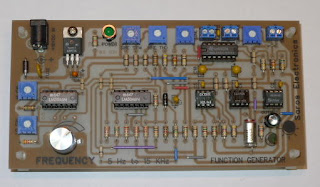The TC1047 is a linear voltage output temperature sensor. The output voltage is directly proportional to the measured temperature with an output voltage response of 10mV / °C
The output voltage range for these devices is typically 100mV at -40°C, 500mV at 0°C, 750mV at +25°C, and 1.75V at +125°C.
The temperature range is from -40 °C to +125 °C.
The accuracy is +/- 2 °C at 25 °C.
TEMPERATURE CIRCUIT OPERATION
In order to achieve the greatest accuracy, an output scaling circuit is used to convert the 100mV to 1.75V sensor output to 0V to +5V for use by the microcontroller’s analog to digital converter.
The 0V output is created by the “zero adjustment” pot which is set for -100mV (offset) and is summed with the output from the temperature sensor. This is performed by operational amplifier #1. The output from this stage is a negative voltage.
The total voltage output from the sensor is 1.65VDC (1.75V – 0.1V). This voltage needs to be amplified in a linear manner to a voltage of +5VDC. OpAmp #2 is used amplify the input by a gain of 3.03 (5.0V / 1.65V). Since the input from OpAmp #1 is a negative voltage, OpAmp #2 is configured as an inverting amplifier which will invert and amplify the negative input into a positive linear output from 0v to +5V. (set with the GAIN adjustment). A 2K resistor and a 1.0uF capacitor are used to filter the final output. A IN4148 diode protects the MCU input from any negative voltages should there be a circuit failure.
The negative five volts is created by a IC7660 voltage converter. The IC7660 will perform voltage conversions from positive to negative for an input range of +1.5V to +10V. Only two external capacitors are required to operate the internal charge pump and output filter.
The LM385 is a micropower voltage reference diode and is used to regulate the -5V output from the IC7660 to -2.0VDC.
MCU OPERATION
A FREESCALE MC9S08QD4 is used as an analog to digital converter and is also programmed to provide a “bit-banged” SPI output to control the FREESCALE
MC14489 five digit display driver. The MC14489 can be programmed to display a limited number of characters such as “°C” and a negative sign for temperatures below zero and also leading zero blanking. The green LED displays used are 0.8” high and are made by LITE-ON.
TEMPERATURE SENSOR CIRCUIT
 |
| CLICK ON FOR LARGER IMAGE |
PROTOTYPE
TEMPERATURE CIRCUIT



















